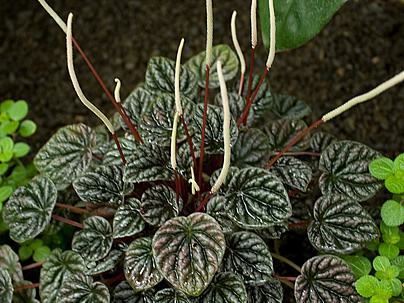The Emerald Ripple Peperomia (Peperomia caperata) is a herbaceous plant with dense, rounded, and highly attractive foliage, cultivated worldwide as an ornamental plant, primarily used in interior decoration. Its leaves are heart-shaped, fleshy, typically dark green with deep, raised veins that give the leaf a “starched” appearance. They are supported by long reddish or pinkish petioles. The tiny, white flowers emerge at various times of the year, arranged along spike-like inflorescences that rise above the foliage.
The inflorescences are thin, cylindrical, and often elongated, resembling a rat’s tail, earning it the popular name in Portuguese “rabo-de-rato.” There are different cultivars of this Peperomia species, with most emphasizing some characteristic of the leaves, such as red, dark green, silver tones, larger or smaller leaves, wider or narrower, etc. Among these, we can mention ‘Emerald Ripple,’ ‘Metallic Ripple,’ ‘Pink Lady,’ ‘Rosso,’ ‘Schumi Red,’ ‘Red Sunshine,’ ‘Variegata,’ ‘White Lady,’ and others.
The Emerald Ripple Peperomia is ideal for both open and closed terrariums, as well as large, shallow pots, decorating countertops, tables, desks, and shelves. It thrives in low-light conditions, where other plant species would perish. In tropical climates, it can also be used as ground cover in gardens, in shaded areas or under the filtered light of trees’ canopies. This makes it an excellent backdrop for compositions with other plants, including other Peperomia species.
It should be cultivated in a location with filtered or diffuse light, avoiding direct sunlight. The substrate should be rich in organic matter, well-draining, and watered to dry slightly between waterings, without allowing it to become waterlogged. In winter, reduce watering to prevent root rot. Despite its delicate appearance, Emerald Ripple Peperomia is quite hardy, adapting well to low-light environments and not being very demanding regarding humidity and leaf spraying.
Pale leaves may indicate too much light, so move it to a more protected location. It is sensitive to intense cold, so in temperate climates, cultivate it indoors or in greenhouses. It is advisable to replant this Peperomia annually, either in a larger pot or by dividing the plant. This refreshes the substrate and revitalizes the plant’s vigor. Fertilize biweekly in spring and summer with half-diluted foliage-specific fertilizers. Propagation is done through leaf cuttings and division of clumps.


